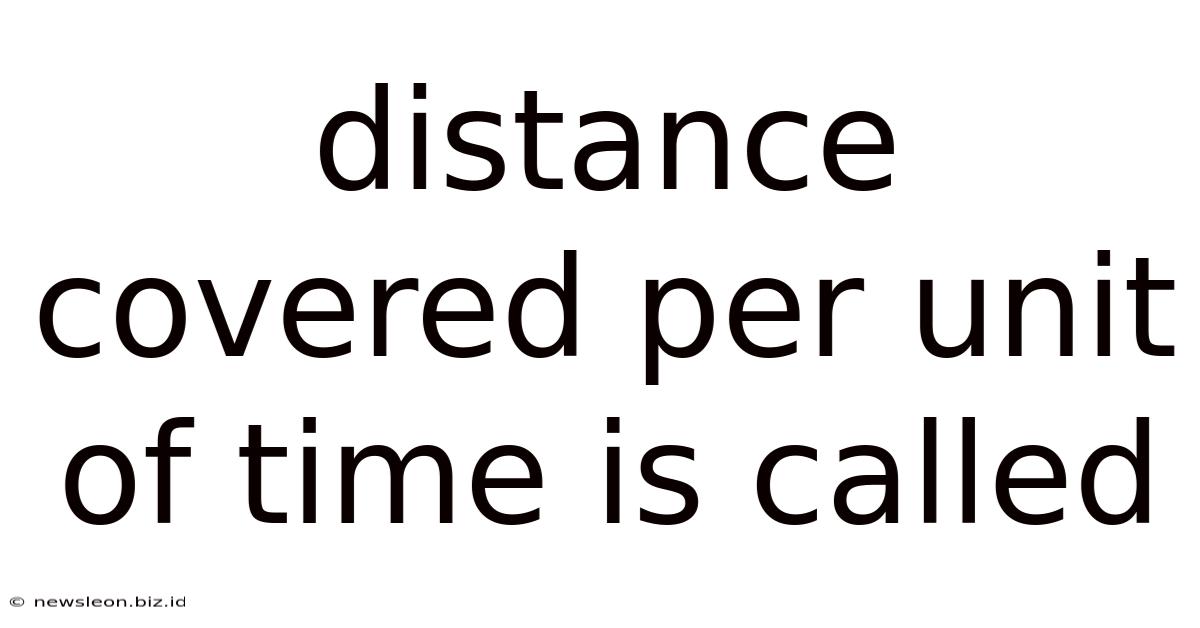Distance Covered Per Unit Of Time Is Called
News Leon
Apr 14, 2025 · 4 min read

Table of Contents
Distance Covered Per Unit of Time Is Called: A Deep Dive into Speed, Velocity, and Their Applications
The fundamental concept of distance covered per unit of time forms the bedrock of many scientific and everyday calculations. While simply stating it's called "speed" is a valid, albeit simplistic, answer, a comprehensive understanding requires delving into the nuances of speed, velocity, and their various applications. This article will explore these concepts in detail, examining their definitions, differences, calculations, units of measurement, and practical examples across diverse fields.
Understanding Speed
In its most basic form, speed is the rate at which an object covers distance. It's a scalar quantity, meaning it only has magnitude (size) and no direction. Think of a car's speedometer – it displays speed, indicating how fast the car is moving but not specifying its direction.
Calculating Speed
The formula for calculating average speed is straightforward:
Average Speed = Total Distance / Total Time
For example, if a car travels 120 kilometers in 2 hours, its average speed is 60 kilometers per hour (km/h or kph).
Units of Speed
Speed is expressed using various units, depending on the context. Common units include:
- Meters per second (m/s): Frequently used in physics and scientific contexts.
- Kilometers per hour (km/h or kph): Commonly used for road travel and everyday situations.
- Miles per hour (mph): Primarily used in the United States and some other countries.
- Feet per second (ft/s): Used in some engineering and specific applications.
Instantaneous Speed vs. Average Speed
It's crucial to differentiate between instantaneous speed and average speed. Average speed represents the overall speed over a given duration, while instantaneous speed is the speed at a specific moment in time. Your car's speedometer displays instantaneous speed.
Introducing Velocity
While speed tells us how fast an object is moving, velocity tells us how fast and in what direction. Velocity is a vector quantity, possessing both magnitude and direction. This distinction is critical in many physical phenomena.
Calculating Velocity
The calculation of average velocity is similar to speed, but it incorporates direction:
Average Velocity = Displacement / Total Time
Displacement is the change in position, a vector quantity indicating both distance and direction from the starting point to the ending point. It's different from total distance, which is the sum of all distances traveled, regardless of direction.
Units of Velocity
Velocity shares the same units as speed: m/s, km/h, mph, and ft/s. However, specifying the direction is essential when reporting velocity. For instance, a velocity of 60 km/h North is different from a velocity of 60 km/h South.
The Difference Between Speed and Velocity: A Clear Illustration
Imagine a runner completing a 400-meter lap on a track. They return to their starting point. The total distance covered is 400 meters. However, their displacement is zero because they ended at the same location they started.
- Speed: If the runner completes the lap in 60 seconds, their average speed is 400m/60s = 6.67 m/s.
- Velocity: Since their displacement is zero, their average velocity is 0 m/s.
This example clearly highlights the crucial difference between speed and velocity.
Applications of Speed and Velocity
Speed and velocity calculations are fundamental to numerous fields:
1. Transportation:
- Navigation: Determining travel times and routes using speed and distance.
- Traffic Management: Monitoring vehicle speeds to improve traffic flow and safety.
- Aviation: Calculating flight paths, speeds, and fuel consumption.
- Maritime Navigation: Determining ship speeds, courses, and arrival times.
2. Physics:
- Kinematics: Studying the motion of objects, including acceleration and deceleration.
- Dynamics: Analyzing forces and their effects on motion.
- Projectile Motion: Calculating the trajectory and range of projectiles.
- Fluid Mechanics: Measuring fluid flow rates and velocities.
3. Meteorology:
- Weather Forecasting: Determining wind speeds and directions.
- Storm Tracking: Monitoring the movement and speed of storms.
4. Astronomy:
- Celestial Mechanics: Studying the motion of planets, stars, and other celestial bodies.
- Cosmology: Measuring the expansion rate of the universe.
5. Sports:
- Performance Analysis: Tracking athlete speeds and velocities during training and competition.
- Game Strategy: Analyzing player movements to improve tactics.
6. Engineering:
- Robotics: Controlling the speed and direction of robotic movements.
- Mechanical Engineering: Designing and analyzing mechanical systems with specific speed and velocity requirements.
- Civil Engineering: Evaluating traffic flow and designing infrastructure to accommodate vehicle speeds.
Advanced Concepts: Acceleration
Understanding speed and velocity paves the way for understanding acceleration, which is the rate of change of velocity. It's a vector quantity, meaning it has both magnitude and direction. Acceleration can be positive (speeding up), negative (slowing down – also called deceleration), or zero (constant velocity).
Calculating Acceleration
The formula for acceleration is:
Acceleration = (Final Velocity - Initial Velocity) / Time
Conclusion
The seemingly simple phrase "distance covered per unit of time" encompasses a rich tapestry of scientific concepts. While speed provides a basic measure of how fast an object is moving, velocity incorporates direction, offering a more complete description of motion. These fundamental concepts, along with acceleration, are essential tools in various fields, enabling us to analyze motion, predict behavior, and build technologies that rely on precise control of speed and velocity. A thorough understanding of these concepts is paramount for progress in numerous scientific and engineering disciplines. From everyday navigation to complex astronomical calculations, the ability to precisely measure and understand distance covered per unit of time is crucial to our world.
Latest Posts
Related Post
Thank you for visiting our website which covers about Distance Covered Per Unit Of Time Is Called . We hope the information provided has been useful to you. Feel free to contact us if you have any questions or need further assistance. See you next time and don't miss to bookmark.